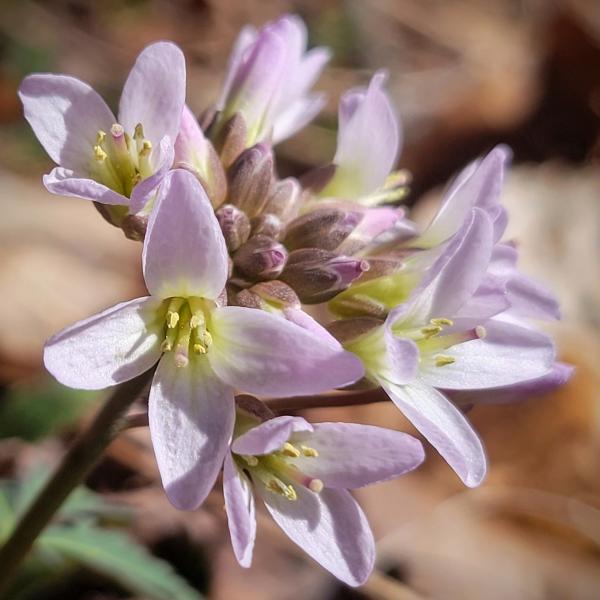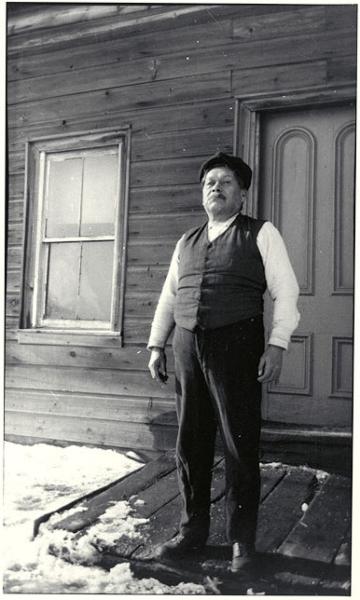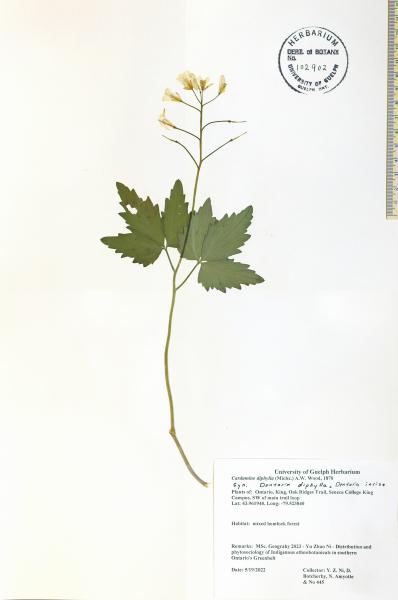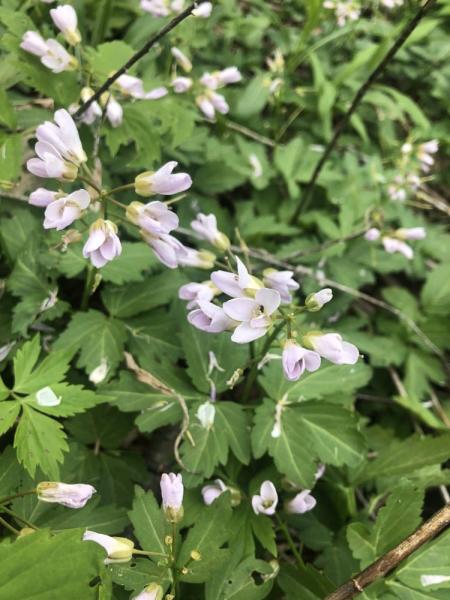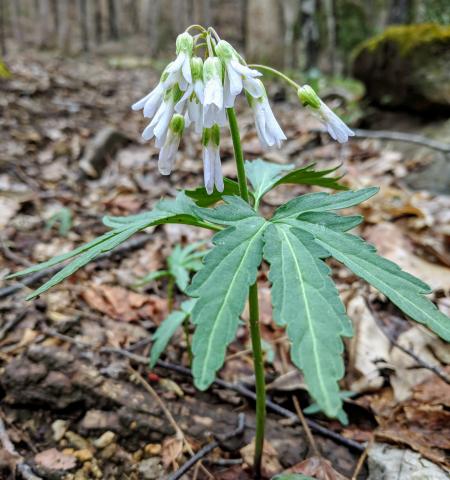
Names and Their Meanings
Pepper root - Cardamine diphylla (Michx.) Alph. Wood
Pepper root
Description
Pepper root is a member of the bittercress genus (formerly Dentaria), and Brassicaceae, the mustard and cabbage family. The roots are connected through runners that extend indefinitely through rhizomes and stolon. The name of the root toothwort refers to toothlike protrusions of the root where it meets the stem. This hardy, evergreen plant then goes dormant through the summer until the fall, when it begins a second growth period and persists through the winter. The leaves have toothy margins that appear palmate in clusters of 3-5 leaflets on each of the two leaf stems. The leaves are compound with 3 oval shaped leaflets attached with very short leafstalks. Pepper root has a similar-looking edible cousin, Cardamine concatenata, the cut-leaved toothwort. Cut-leaved toothwort leaves are slender and deeply lobed in appearance, and are arranged around the stem in a whorl. This Native plant that is endemic to Eastern North America grows in rich, damp woods and meadows. It grows on slopes, out of leaf litter, in partial or dappled shade, but does not grow under the deep shade of fir trees. Pepper root prefers growing in leaf litter from deciduous trees, is dormant during the summer, and then active in the fall and winter. Pepper root grows on rich, moderately moist soils in woods and woodland edges, cliffs, bluffs, ledges, shaded slopes, meadows, stream banks and swampy areas.
Conservation Status
S5 (Secure) in Ontario
Hardy in zones 3 – 8, in the Eastern half of North America from Ontario and Minnesota south to South Carolina, and eastward. Cardamine diphylla and Cardamine concatenata are abundant and not threatened.
Uses
Pepper root’s hardiness and abundance is one reason why people used it historically as a wild food and a famine food. The roots eaten with salt, added to salads and soups, are pickled, or eaten as a relish. They are thought of as blood cleaners; combined with Acorus calamus to strengthen the heart; they alleviate gas and are nourishing for the gastrointestinal system. Pepper root was one of the first edible Haudenosaunee plants that Dr. Jessica Dolan learned about when she first went to visit Six Nations of the Grand River in 2009. She was advised to go visit the late Onondaga Beaver Clan Chief Arnold General to introduce herself and tell him about her research interests and studies; along with all of his responsibilities as Confederacy Chief, Arnie General dedicated himself to hosting and cross-cultural education with scholars. When she visited, he told her pepper root was his favorite snack, handed her a root to try, and proceeded to have a good laugh when he saw her face react to the peppery, horseradish-like flavor! Arnie went out to collect the roots himself and he kept them in the refrigerator, along with other vegetables. He ate them on sandwich bread. When he became elderly and couldn’t go collect them himself any longer, other people brought him pepper root. Later, in 2011, when Dr. Dolan interviewed faithkeeper and farmer Christine Skye at Six Nations of the Grand River, she also described pepper root as one of the medicines/ foods that her family would go collect in the springtime.
Like Chief Arnold General, Chief John Arthur Gibson and his wife, Mary Skye Gibson dedicated their lives to cross-cultural education and leadership. At the turn of the 20th century, they worked with local and non-Indigenous scholars to record and preserve Haudenosaunee knowledge for intergenerational transmission. John Arthur and Mary Skye Gibson dedicated a lot of their time and knowledge to teaching Frederick Wilkerson Waugh about Haudenosaunee culture and knowledge, which is evident in his extensive recordings in his field notebooks, from his visits with them. In January of 1912, when they were telling Waugh all about traditional foods, they described Pepper root as being eaten with salt, added to meat soups, and used as a famine food. Here is a portrait of John Arthur Gibson that F. W. Waugh took outside of his house in 1912. A good time to collect its leaves and roots is in the fall because it is dormant in the summer – both leaves and roots are edible raw and cooked.

